Sybille Garrels, M.A.:
In a time of inundation with images...

... and a sheer ungraspable profusion of photo literature, it seems to be of particular significance for today’s man to identify those aspects that unite and separate the phenomenon of art and photography. The initiation of the sensitive perception of images of all kinds needs to be at the center of the observations made.
Pictorial sensations assault, batter and daze us daily. Aggressive colours, stimulation, irritation, huge and imposing dimensions overwhelm all image perception.
Technique, colour appeal, thematic freedom, everything surprises and is meant to surprise us today, but the possibilities of photographic expression have a very different objective. The viewer is to be moved towards immersion in an image, to appreciate all its qualities and intimations, a precondition for which is a comprehensive view, increased knowledge and enhanced understanding. Photography like all visual art creates images, very varied and diverse, but always images. Man’s special ability to perceive images relies on a functioning facial sense, the eyes’ perception of colour and lightness, and psychophysical perception. This complex process of selection from among the received impulses results in the creation of an image that concentrates emotional impact and evokes profound sentiments.
The process of selection is by no means conscious. In the deep strata of the individual personality is unconsciously determined what is perceived. This can be stringently formulated: -
Man only sees what is within him. Many artists have dwelt on this phenomenon. In 1799 William Blake wrote in a letter ‘the tree that moves to tears of joy, is but a green obstacle in the eyes of another. To some, nature seems ridiculous and deformed, others hardly notice it. However, in the eyes of the talented, imaginative man nature itself is fantasy and vision. As a man is, he sees.’ In this regard it is important to clearly state that training, a deepening of understanding, and enhancing of receptivity, the sensitization of man particularly at this time of excessive stimulation is of paramount importance.
The effect of images varies, after all the whole scale of human thought and feeling are addressed by optical information. All of man is affected from his intellect to the mysterious visions of the unconscious and the world of dreams. The many-layered nature of man can, but need not, lead to conflict. The aim is to harmonize the various layers. Art is able to contribute towards equilibrium. The creative process is a way of thinking about life. Reflection is a more active process than looking at. Reflection is the will to see reality, to become absorbed in it, to collaborate at its discovery and understanding.
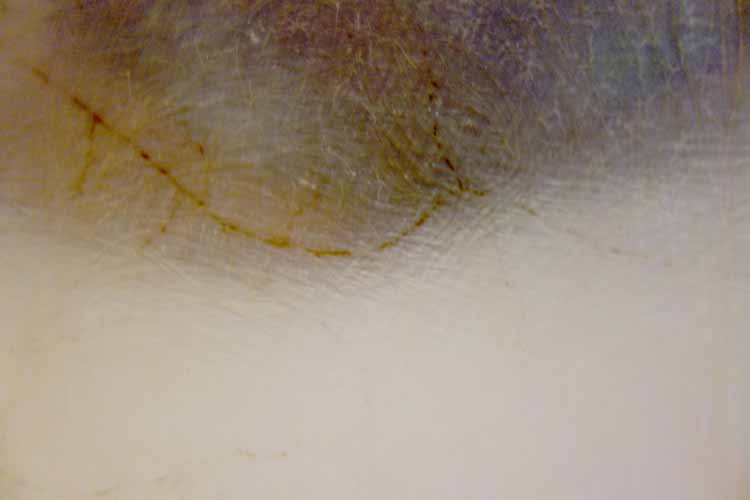

The photos of Monika M. Seibel are an excellent example of this process. She works like composers in variations. She creates a sequence of works that only differ in details. It is astonishing how a very slight change in colour, an alteration effected by consciously used precision and imprecision, a change in distance, of light and shade immediately express very different sensual states. The infinite abundance of possibilities and variations of which we view only a few in this exhibition is fascinating. All the sequences found in the fine handmade boxes in DinA4 format and the small books on sale. Each of her images has its own individuality, is a self-sufficient piece of reality. We as viewers are encouraged to reach out towards her work with respect, spiritual composure and concentration. That which is represented in Monika M. Seibel’s images invites you to linger. Her way of seeing objects and nature has the effect of a discovery, touches you with its timeless tranquility. Her images are poetic; they are different from what you generally see in a time in which everyone owns a camera, in a world in which the media flood the market with artistic photography, an era in which foreign lands arise and pass with the turning of a page, where television broadcasts events seconds after their occurrence. In such a time the images of the artist offer something special. Her photos are mysterious. She sees the magic of objects many of us would pass by carelessly; she shows the hidden beauty of plain, simple objects in impressive diversity. Like Pippi Langstrumpf she is a finder of treasure, not a treasure seeker.
Let us look around in this first room. At the head “identified object”, a plastic bag over a truss of hay, here in Hilden. A luminous coloured object against a dark sky which holds me spellbound. The moving folds are reminiscent of the drapery of baroque clothes. The green colour amazes me, I have never seen such coverings. However, Monika M. Seibel has seen many of them as illustrated in her photo book “Abstractions”, where she shows variations on the theme of fodder coverings, whose green colours are fascinating; once more focused and unfocused diversity, which results in the mysterious and magic effect of the works.
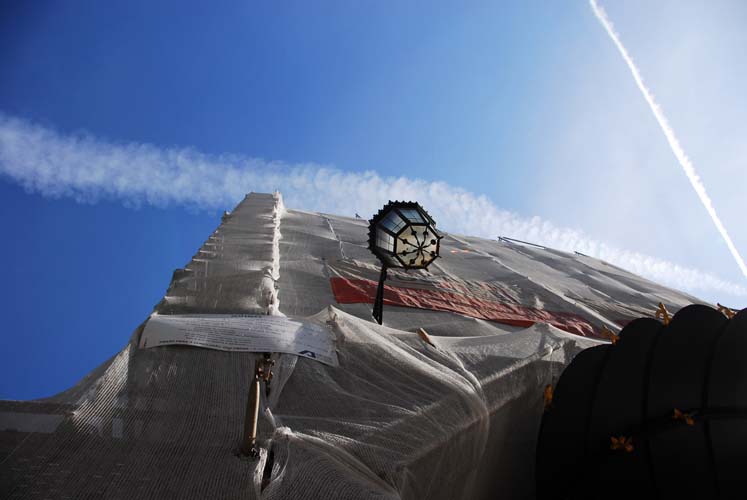
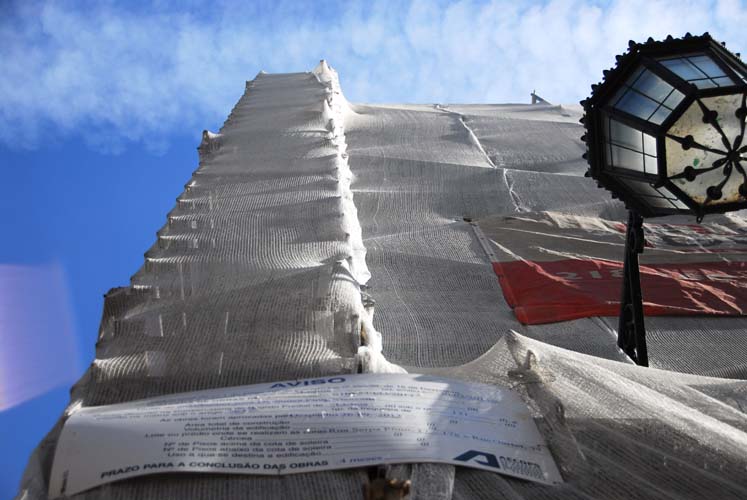
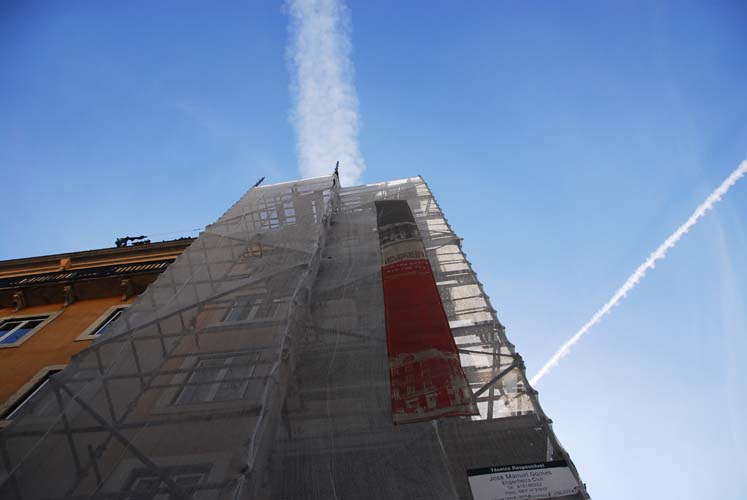
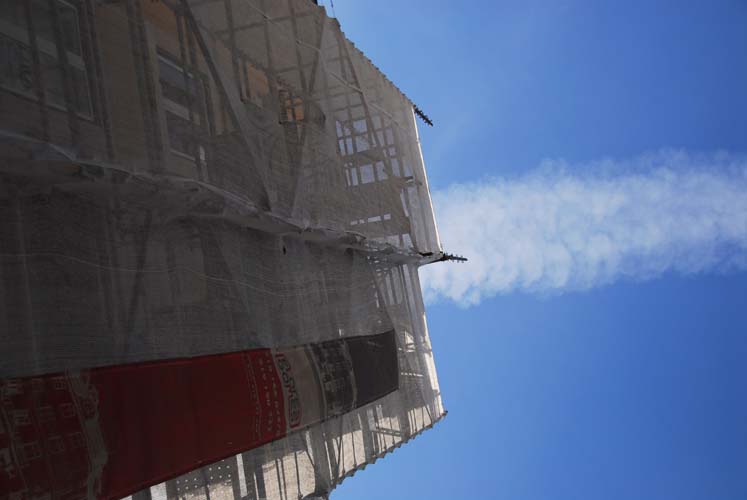
The photo sequence “the beautify mantle” illustrates how the artist succeeds in making plastic foils draped over plants for protection or thrown aside as waste after their use speak. Light and shade, light and light reflection create magical, mysterious works. The theme harbour, her first series 2000, whose title is “absent sea” is presented in different versions. We see the large work: a buoy with anchor and cloth as well as three photos with buoys, which are normally employed for the safety of river navigation, resting in the port.
All, who have passed building sites, know the protective shrouds of houses. But who has ever noticed their details. One registers their appearance but does not look keenly. That is where Monika M. Seibel differs. Her trained eye discovers density and transparency, the movement of the foils caused by wind. The deep colour of new foils, the weathered and faded appearance of old shrouds that symbolize the transience of all matter and all life..
The same motive of ‘weathering’ we see in the sequence “Babel” of plastic film wrapped manure weighted by old tires. The plastic foil is torn, the tires displaced. But there is even more to see. New life is springing forth from among this mountain of refuse: birth and decay, a central theme of all art.
The title “memento” refers to a sequence in the back room and hallway, about which I will not say much. These images “diario di venezia”, or “alien skin”; “memento”, “luxus” and “estuary” are sequences whose beautiful colours, the mingling of brightness and darkness, light and shade, precise and blurred shots, close and distant, speak for themselves. Monika M. Seibel illustrates with her creations that photography is not only beholden to the visible but is fully open to the spiritual. Her art is a message, the discovery of a new reality. The artist shows that photographic art is an infinite field of creativity. It would appear that the artist’s talent is far from exhausted. I wish the artist and her exhibition the success it deserves and the listeners much joy in looking at the remarkable and inspiring photos. Thank you for your attention.


